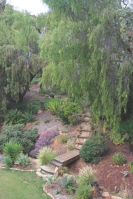
This garden and others will be on view at the Sage & Songbirds Garden Tour May 2-4 in Alpine
Story by Maureen Austin, CHIRP
Photos by Mendi Wyatt, CHIRP
April 15, 2014 (Alpine) - Laughingly labeled as a “plant hoarder” by a friend, Pete Swoboda prefers the title “plant collector.” He says he never met a plant he didn’t like, and although he has hundreds of different plants growing in his near-acre garden, he purchased less than 20 percent of them. The balance were gifts or starts he propagated from cuttings.
He does have his favorites, however. Swoboda is partial to cycads and fragrant flowers, and is especially fascinated with the intensely aromatic night-bloomers. Whereas most gardeners toss in the trowel at dark, he is often just getting started! Wearing a lighted miner’s cap, and with the aid of additional flood lights, he gardens.
“I do my best design work after sunset,” he says, “without the background pollution.”
Most night-blooming plants are intensely fragrant, and many people miss the experience of enjoying them by being indoors, he said. Most people, in fact, are not even aware that many common plants have fragrant flowers. He cites the philodendron, of which he grows several varieties.
“The philodendron flower completely fills the air with fragrance after sunset--but weather conditions have to be just right,” he said. “Warm and humid.” He said their bloom usually occurs about the third week of June--an observation he has made in the 32 years he’s been gardening in his Alpine home.
A collection of tropicals and other plants usually only grown indoors in this area, fill the deck and areas immediately outside of his home, where he can provide them with summer shade.
 Throughout the rest of his property is the balance of Swoboda’s plant collection, along with his workshop and greenhouse.
Throughout the rest of his property is the balance of Swoboda’s plant collection, along with his workshop and greenhouse.
A long, meandering path wraps around a small lawn area and over a dry creek, and includes a mix of succulents, grasses, perennials, palms, cycads, bromeliads, and natives.
He describes his garden as “forest-like but not manicured”, with its abundance of trees and plants. “I like a lot of plants, but not a mess,” he said. “And I don’t like things cut into shapes.”
Swoboda said he tries to allow space between plants. “People plant too close and pretty soon they have a big ‘wust’,” he laughs. (“Wust” is the German translation for “mess”, German-born Swoboda explains.)
His best advice to new gardeners is to plant trees. With over 2 dozen fruit trees--along with mimosa, palm, pepper, eucalyptus, oak and more--his yard is alive with the song of birds and butterflies by day, and bats and moths by night.
Although visitors will not find an evening showing for this garden, there is plenty to see during the day. It is Garden #3 on the Sage & Songbirds tour.
Tour Information:
- Five fabulous, never-before-seen Alpine gardens are showcased in this year's tour, plus a place-of-worship garden and raptor rehabilitation facility. Admission to all seven sites is $20.
- Ticket includes a map for the self-guided tour, and is valid all three days of the event. Visitors may stay as long as they desire in each garden.
- Tickets may be purchased in person at Jennifer's Feed or Alpine Garden & Gifts. Cash or checks only at those locations.
- To purchase online with credit card, please visit www.chirp.org.
- Instructions to purchase by mail may also be found at www.chirp.org, or by phoning 619-445-8352.
- The event is hosted by CHIRP for Garden Wildlife, Inc.







Recent comments